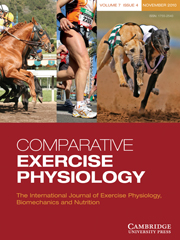Article contents
A comparison of the metabolic cost of the three phases of the one-day event in female collegiate riders
Published online by Cambridge University Press: 09 February 2010
Abstract
Few studies exist regarding the physiological responses of equestrian riders during actual or simulated competition. Interest has proliferated in recent years on the responses of riders, which is mainly due to the fatal tragedies that occurred in eventing in the late 1990s. More emphasis is also being placed on the importance of riders, fitness in order to improve athletic performance at the international level. The aim of the present study was to investigate the fitness and exercise capacity of female equestrian athletes, and to relate this to the metabolic requirements of dressage (DR), showjumping (SJ) and cross-country (XC) phases of the one-day event. Sixteen female collegiate riders (age = 24.5 ± 7.7 years; height = 166.6 ± 3.8 cm; weight = 60.4 ± 6.0 kg) competed in a simulated Horse Trials Pre-Novice competition riding either their own horse or one familiar to them. Anthropometric data were obtained for each rider (body mass index (BMI) = 21.7 ± 1.9; % body fat (BF) = 23.4 ± 5.3; lean body mass (LBM) = 48.5 ± 3.6). Each subject successfully completed all three phases of the event. There was a progressive increase in oxygen consumption (VO2) during the three phases (DR, SJ and XC) from a mean value of 20.4 ± 4.0 ml kg− 1 min− 1 (DR), 28.1 ± 4.2 ml kg− 1 min− 1 (SJ) to 31.2 ± 6.6 ml kg− 1 min− 1 (XC) (P < 0.001). Heart rate data showed a similar trend from a mean value of 157 ± 15 beats min− 1 (DR), 180 ± 11 beats min− 1 (SJ) to 184 ± 11 beats min− 1 (XC) (P < 0.001). Mean lactate concentration increased progressively from resting values: rest 2.5 ± 1.3 mmol, DR 4.8 ± 1.8 mmol, SJ 7.8 ± 2.4 mmol and XC 9.5 ± 2.7 mmol (P < 0.001). Urine osmolality was significantly (P < 0.001) increased from a pre-competition mean of 0.488 ± 0.270 mOsmol l− 1 to a post-competition mean of 0.684 ± 0.230 mOsmol l− 1. Mean hand grip strength was observed to decrease significantly (P < 0.01) from a pre-value of 32.3 ± 6.3 kg to a post-value of 29.8 ± 5.5 kg. Mean weight loss pre- to post-competition was 1.6 ± 1.1% body weight (P < 0.01). In conclusion, the study emphasises the variability in metabolic cost between riders performing in the same simulated competition but riding different horses, and highlights the difference in metabolic demand between the different phases.
Information
- Type
- Research Paper
- Information
- Copyright
- Copyright © Cambridge University Press 2010
Footnotes
Present address: School of Physical Education, University of Otago, Dunedin, New Zealand.
References
- 24
- Cited by

